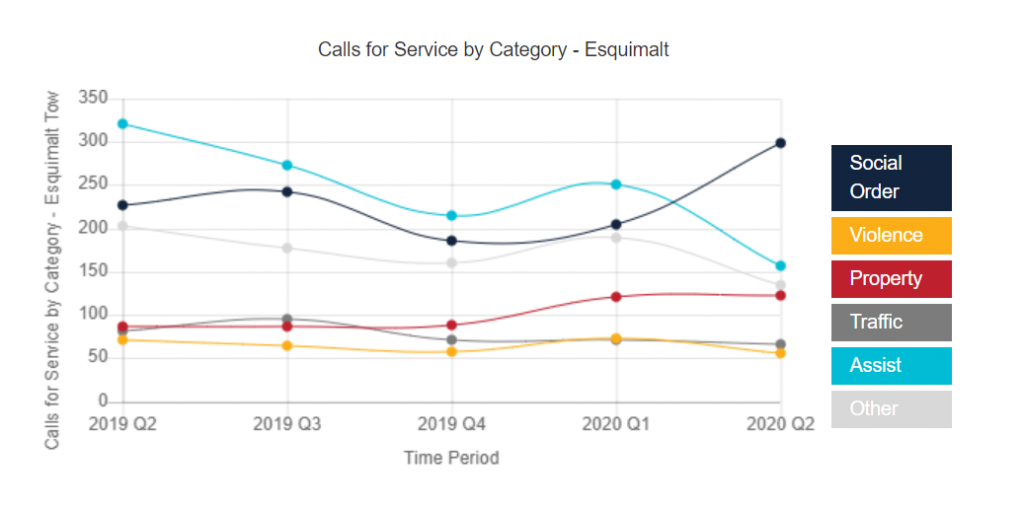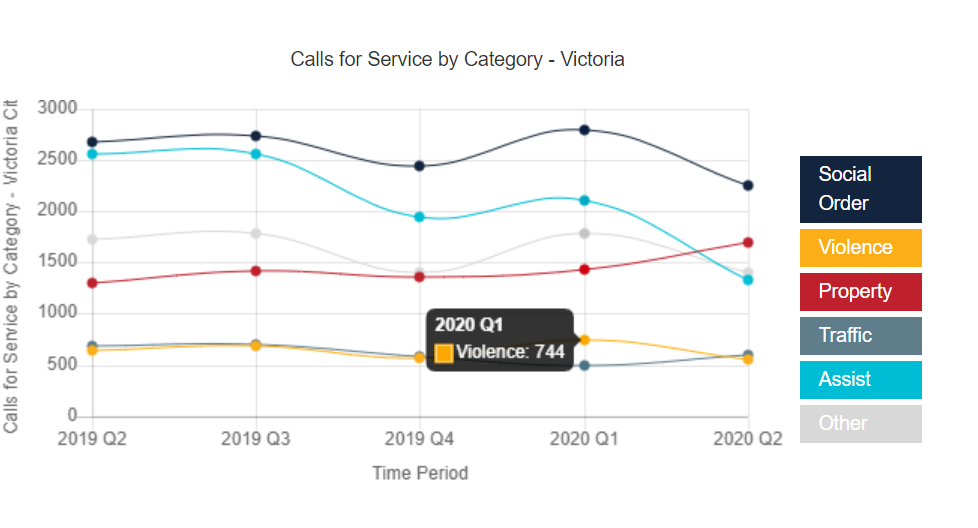Date: Wednesday, September 23 2020
Victoria, BC – VicPD is striving to be as transparent and accountable as possible. That’s why we have launched Open VicPD as a one-stop hub for information about the Victoria Police Department. Here you’ll find our interactive VicPD Community Dashboard, our online quarterly reports, publications, and other information that tells the story of how we are working towards our strategic vision of “A Safer Community Together.”
Today, we’re introducing our Quarterly Reports.
VicPD provides police services to the two municipalities we serve – the City of Victoria and the Township of Esquimalt. A component of the Framework Agreement that outlines how we provide policing services includes the delivery of quarterly reports. The quarterly reports include a variety of statistics and a summary of service information and trends for both municipalities for each quarter. There are four quarters in each year; Q1 | January – March, Q2 | April – June, Q3 | July – September, Q4 | October – December. The quarterly reports contain data collected for 33 different measures. Some of this data is available for each municipality, while other data is only available for our full jurisdiction. Some of this data is presented quarterly, some annually, and some, like measures taken from our Community Surveys, are only currently available in a three-year cycle. Additionally, some measures like the Crime Severity Index and Crime Rate are provided by Stats Canada on an annual basis. The Framework Agreement provides the mechanism through which the Victoria and Esquimalt Police Board establish the measures which they feel will best inform the City of Victoria and the Township of Esquimalt of VicPD’s quarter by quarter performance. These measures evolve over time.
The current 33 quarterly report measures are:
|
|
|
Esquimalt Specific
|
Victoria Specific
|
VicPD overall
|
Today we’re going to focus on one specific measure, Calls for Service.
What is a call for service?
A Call for Service (CFS) is a request for services from or report to the police department that generates any action on the part of the police department or partner agency performing work on behalf of the police department (such as E-Comm 9-1-1). A CFS includes recording a crime or incident for reporting purposes. A CFS is not generated for proactive activities unless the officer generates a specific CFS report. The measures in the Quarterly Reports are for total as well as dispatched calls for service; calls assigned to an officer, or someone else in the department or partner agency. We currently average about 55,000 calls for service a year. These are displayed by quarter.
Why do we measure calls for service?
Calls for service are a good indicator of how busy VicPD officers and staff are as we respond to the public’s requests for assistance. The large majority of incidents that officers respond to don’t result in criminal charges, which is why calls for service is a much better indicator than crimes for how our resources are being used.
The quarterly Calls for Service graphs provide quarterly overall call for service measures and then break these out between Victoria and Esquimalt across six categories. These six categories are:
- Social order – call types include disturbance, man down, unwanted person, etc.
- Violence – call types include assault, sexual assault, robbery, etc.
- Property – call types include break and enters, theft from vehicles, theft of vehicles, etc.
- Traffic – call types include collision response, impaired driving and other traffic offences.
- Assist – call types include requests to assist BC Emergency Health Services paramedics, Parole, other police departments, etc.,
- Other – calls are those which do not fit into the categories above.
The lines show the trend for each three month period. Hovering over the point in time dots reveals the specific number of calls for service for that category at that point in time.
Quarterly Reports Before Open VicPD Format
An archive of our Quarterly Reports from 2015-2019 is available. The format for these reports differs significantly from year to year and from the Open VicPD Quarterly Report format. The new, Open VicPD format is the result of five years’ experience of working with the Quarterly Reports through the Framework Agreement mechanisms and represent an ongoing evolution of measures and approaches to reporting out on VicPD. The Victoria and Esquimalt Police Board’s leadership and vision has been essential in focusing our Quarterly Reports into this new, open snapshot-style format.
We Want to Hear From You!
As part of our goals to improve your understanding of how we work and what measures we’re using and why, we welcome your feedback. Please email us your questions and suggestions.
Up Next
Next week, we take a further deeper dive into Calls for Service and their 5-year trend as displayed in our Community Dashboard. We’ll be walking you through each of the goals and their subsequent measures in detail over the coming weeks. Each week we’ll look at one of these measures in detail to help you understand what we’re measuring, why we’re measuring it and how we think it helps you track our progress towards achieving our goals. Join us on Twitter, Facebook, Instagram and VicPD.ca to come along for a deeper dive into Open VicPD.




